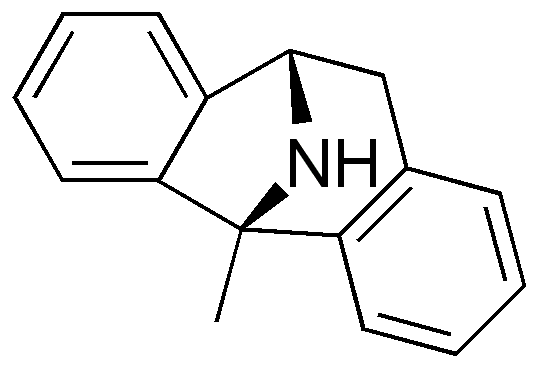Dizocilpine
 | |
| Clinical data | |
|---|---|
| Pregnancy category |
|
| Routes of administration | Oral, IM |
| ATC code | |
| Legal status | |
| Legal status |
|
| Pharmacokinetic data | |
| Bioavailability | ? |
| Metabolism | ? |
| Elimination half-life | ? |
| Excretion | ? |
| Identifiers | |
| |
| CAS Number | |
| PubChem CID | |
| DrugBank | |
| E number | {{#property:P628}} |
| ECHA InfoCard | {{#property:P2566}}Lua error in Module:EditAtWikidata at line 36: attempt to index field 'wikibase' (a nil value). |
| Chemical and physical data | |
| Formula | C16H15N |
| Molar mass | 221.297 |
| Melting point | 68.75 °C (155.75 °F) |
Dizocilpine, also known as MK-801, is a non-competitive antagonist of the NMDA receptor. It binds inside the ion channel of the receptor and thus prevents the flow of ions such as calcium (Ca2+) through the channel. Dizocilpine blocks NMDA receptors in a use- and voltage-dependent manner, since the channel must open for the drug to bind inside it. The drug is an anti-convulsant.
Possible future medical uses
The effects of MK-801 at NMDA receptors are clear and significant. NMDA receptors are key in the progression of excitotoxicity (a process in which an excessive amount of extracellular glutamate overexcites glutamate receptors and harms neurons). Thus NMDA receptor antagonists including MK-801 have been extensively studied for use in treatment of diseases with excitotoxic components, such as stroke, traumatic brain injury, and neurodegenerative diseases such as Huntington's, Alzheimer's, and amyotrophic lateral sclerosis. MK-801 has shown effectiveness in protecting neurons in cell culture and animal models of excitotoxic neurodegeneration.[1][2][3] However, NMDA antagonists like MK-801 have largely failed to show safety and effectiveness in clinical trials, possibly due to inhibition of NMDA receptor function that is necessary for normal neuronal function. Since MK-801 is a particularly strong NMDA receptor antagonist, this drug is particularly likely to have psychotomimetic side effects (such as hallucinations) that result from NMDA receptor blockade. MK-801 had a promising future as a neuroprotective agent until neurotoxic-like effects, called Olney's Lesions, were seen in certain brain regions of test rats.[4][5] Merck, a drug company, promptly dropped development of MK-801.
Recreational use
Dizocilpine may be effective as a recreational drug, and may have an active dose in the 50-100μg range. Little is known in this context about its effects, dosage, and risks. Dizocilpine's high potency makes its dosage more difficult to accurately control when compared to other similar drugs. As a result, the chances of overdosing are high. Users tend to report that the experience is not as enjoyable as other dissociative drugs, and it is often accompanied by strong auditory hallucinations. Also, dizocilpine is much longer-lasting than similar dissociative drugs such as ketamine and phencyclidine (PCP), and causes far worse amnesia and residual deficits in thinking, which have hindered its acceptance as a recreational drug.
References
- ↑ Ayala GX, Tapia R. 2005. Late N-methyl-D-aspartate receptor blockade rescues hippocampal neurons from excitotoxic stress and death after 4-aminopyridine-induced epilepsy. European Journal of Neuroscience. Volume 22, Issue 12, Pages 3067-3076. Accessed January 7, 2007.
- ↑ Kocaeli H, Korfali E, Ozturk H, Kahveci N, Yilmazlar S. 2005. MK-801 improves neurological and histological outcomes after spinal cord ischemia induced by transient aortic cross-clipping in rats. Surgical Neurology. Volume 64, Supplement 2, Pages S22-S26; discussion S27. Accessed January 7, 2007.
- ↑ Mukhin AG, Ivanova SA, Knoblach SM and Faden AI. 1997. New in vitro model of traumatic neuronal injury: Evaluation of secondary injury and glutamate receptor-mediated neurotoxicity. Journal of Neurotrauma. Volume 14, Issue 9, Pages 651-663. Accessed January 7, 2007.
- ↑ Olney J, Labruyerre J and Price MT. 1989. Pathological changes induced in cerebrocortical neurons by phencyclidine and related drugs. Science, Volume 244, Issue 4910, Pages 1360-1362. Accessed January 7, 2007.
- ↑ Ellison G. 1995. The N-methyl-D-aspartate antagonists phencyclidine, ketamine and dizocilpine as both behavioral and anatomical models of the dementias. Brain Research. Brain Research Reviews, Volume 20, Issue 2, Pages 250-267. Accessed January 7, 2007.
External links
- Pages with script errors
- Drugs with non-standard pregnancy category
- Drugs with non-standard legal status
- E number from Wikidata
- ECHA InfoCard ID from Wikidata
- Chemical articles with unknown parameter in Infobox drug
- Articles without EBI source
- Chemical pages without ChemSpiderID
- Articles without KEGG source
- Articles without InChI source
- Articles without UNII source
- Articles containing unverified chemical infoboxes
- NMDA receptor antagonists
- Drugs
- Dissociatives